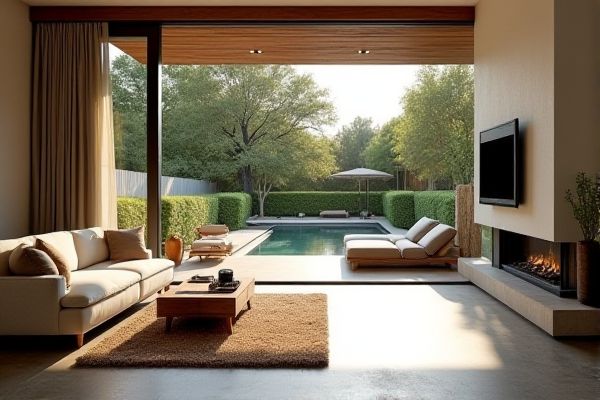
A patio is a ground-level outdoor space often paved and located directly outside a house, whereas a terrace is typically an elevated flat area built on a rooftop or hillside, designed for relaxation or entertainment. Explore the rest of the article to discover which option best suits Your outdoor living needs.
Table of Comparison
| Feature | Patio | Terrace |
|---|---|---|
| Location | Ground level, typically adjacent to a house | Elevated, built on rooftops or upper levels |
| Construction | Solid surface made of concrete, stone, or brick | Flat, open outdoor space, often paved or tiled |
| Purpose | Outdoor living area for dining and relaxation | Outdoor space for leisure, sometimes garden or seating |
| Accessibility | Direct access from ground floor rooms | Access usually from upper floors or rooftop |
| Structure | Typically uncovered, may have pergolas or awnings | Often exposed, sometimes has railings or walls |
| Common Uses | Barbecue, family gatherings, outdoor furniture setup | Lounging, gardening, panoramic views |
Patio vs Terrace: Key Differences Explained
A patio is typically a ground-level outdoor space made of concrete, stone, or brick, often located directly adjacent to a building and used for dining or recreation. A terrace can be an elevated, flat area built on a slope or rooftop, designed for leisure with features like railings or planters. Key differences include the patio's ground-level placement versus the terrace's raised position, affecting structural requirements and views.
Defining a Patio: Features and Functions
A patio is an outdoor space typically paved with concrete, stone, or brick, located at ground level adjacent to a house, designed for dining, relaxation, and entertainment. It often includes features such as seating areas, fire pits, and shade structures, enhancing outdoor living experiences. Patios serve as versatile extensions of indoor spaces, providing a durable and functional area for various activities.
What is a Terrace? Understanding Its Purpose
A terrace is an elevated, often flat outdoor space designed for relaxation, dining, or entertainment, typically attached to a building or situated on a rooftop. Unlike a patio, which is usually ground-level and made from concrete or stone, terraces can incorporate various materials like wood or tiles and offer views overlooking gardens or landscapes. Your terrace serves as an extension of your living space, providing a versatile area that enhances both aesthetic appeal and functionality.
Location Matters: Where Patios and Terraces Are Built
Patios are typically constructed at ground level, often directly attached to a home's backyard or garden, providing easy access to outdoor living spaces. Terraces are usually elevated structures, either on rooftops or upper levels of buildings, offering expansive views and maximizing limited outdoor areas in urban settings. The location of patios and terraces significantly influences their design, functionality, and integration with the surrounding environment.
Materials Used for Patios and Terraces
Patios are commonly constructed using materials such as concrete, brick, stone, and pavers, offering durability and a range of aesthetic options for outdoor living spaces. Terraces often feature materials like natural stone, wood decking, and tiled surfaces, designed to blend seamlessly with elevated or landscaped environments. The choice of materials impacts not only the visual appeal but also the maintenance and longevity of patios and terraces.
Design Considerations: Style and Aesthetics
Patios often feature materials like concrete, brick, or natural stone, lending a rustic or traditional charm that complements garden landscapes, while terraces tend to incorporate sleek, modern surfaces such as wood decking or tile, offering a contemporary aesthetic. Your choice should align with the architectural style of your home and surrounding environment, ensuring visual harmony and enhancing outdoor living appeal. Consider how design elements like furniture, lighting, and greenery will interact with the base structure to create a cohesive and inviting outdoor space.
Usability and Outdoor Activities
Patios offer versatile usability for outdoor activities such as barbecues, dining, and lounging, often directly connected to the home's interior for seamless indoor-outdoor flow. Terraces, typically elevated and more expansive, provide panoramic views and ample space ideal for gardening, sunbathing, and hosting larger gatherings. Both spaces enhance outdoor living but differ in design and functionality depending on elevation and size.
Cost Comparison: Patio vs Terrace Construction
Patio construction generally costs less than building a terrace due to simpler design and lower material expenses, with average patio costs ranging from $1,500 to $4,000 depending on size and materials like concrete or pavers. Terrace construction involves more extensive labor, foundation work, and sometimes retaining walls, pushing prices between $5,000 and $15,000 or more. Your budget and terrain will significantly influence whether a patio or terrace is the more cost-effective choice for your outdoor living space.
Maintenance Requirements for Patios and Terraces
Patios typically require regular cleaning and sealing to prevent damage from moisture and UV rays, making maintenance relatively straightforward. Terraces, especially those elevated or landscaped, demand more intensive upkeep such as structural inspections, drainage management, and waterproofing to ensure durability. You should consider these maintenance factors when choosing between a patio and a terrace to match your lifestyle and budget.
Choosing Between a Patio and a Terrace for Your Home
When choosing between a patio and a terrace for your home, consider the specific design and functional differences: patios are typically ground-level paved areas ideal for casual outdoor living, while terraces are elevated platforms that often provide better views and can be integrated into hillside landscapes. Your decision should factor in space availability, desired aesthetics, and how you plan to use the outdoor area, as terraces may require more structural support and investment compared to patios. Prioritize materials and layout that complement your home's architecture and lifestyle needs to create an inviting outdoor environment.
 homyna.com
homyna.com